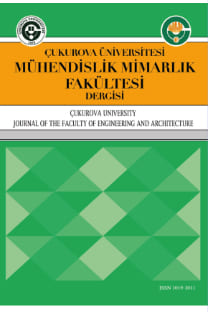Casting the Swarms Problem in the Ensembles Context
Sürüler Probleminin Topluluk Bağlamı Açısından Modellenmesi
___
1.Rauch,E.M.,Millonas,M.M.,Chialvo,D.R., 1995.Pattern Formation and Functionality in Swarm Models,Physics Letters A207, no. 3-4: 185-93. doi:10.1016/0375-9601(95)00624-c.2.Martinoli,A.,Easton,K.,Agassounon,W., 2004.Modeling Swarm Robotic Systems: A Case Study in Collaborative Distributed Manipulation,Int J Robot Res The International Journal of Robotics Research23, no. 4: 415-36. doi:10.1177/0278364904042197.
3.Chen,S.,Fang,H., 2006.Modeling and Stability Analysis of Social Foraging Swarms in Multi-obstacle Environment. J. Control Theory Appl,Journal of Control Theory and Applications4, no. 4: 343-48. doi:10.1007/s11768-006-5170-8.
4.Arlotti,L.,Deutsch,A.,Lachowicz,M., 2005.A Discrete Boltzmann-type Model of Swarming,Mathematical and Computer Modelling41, no. 10: 1193-201. doi: 10.1016/j.mcm.2005.05.011.
5.Zhao,Y.,Zu,W.,Zeng,H., 2009.A Modified Particle Swarm Optimization via Particle Visual Modeling Analysis,Computers & Mathematics with Applications57, no. 11-12: 2022-029. doi: 10.1016/j.camwa.2008.10.007.
6.Lin,Y.,Chang,W.,Hsieh,J., 2008.A Particle Swarm Optimization Approach to Nonlinear Rational Filter Modeling, Expert Systems with Applications34, no. 2: 1194-199. doi: 10.1016/j.eswa.2006.12.004.
7.Wu,Q.,2010.A Hybrid-forecasting Model Based on Gaussian Support Vector Machine and Chaotic Particle Swarm Optimization,Expert Systems with Applications37, no. 3: 2388-394. doi: 10.1016/j.eswa.2009.07.057.
8.Chan,K.Y.,Dillon,T.S.,Kwong,C.K., 2011.Polynomial Modeling for Time-varying Systems Based on a Particle Swarm Optimization Algorithm,Information Sciences181, no. 9: 1623-640. doi: 10.1016/j.ins.2011.01.006.
9.Cleghorn,C.W.,Engelbrecht,A.P., 2014.A Generalized Theoretical Deterministic Particle Swarm Model,Swarm Intell Swarm Intelligence8, no. 1: 35-59. doi:10.1007/s11721-013-0090-y.
10.Zhang,J.,2013.Canonical Ensemble Model for the Black Hole Quantum Tunneling Radiation,Chinese Physics Letters Chinese Phys. Lett.30, no. 7: 070401. doi:10.1088/0256-307x/30/7/070401.
11.Sierra,G.,Román,J.M.,Dukelsky,J., 2004.The Elementary Excitations of the Bcs Model in the Canonical Ensemble,International Journal of Modern Physics A Int. J. Mod. Phys. A19, no. Supp02: 381-95. doi:10.1142/s0217751x04020531.
12.Zhang,J., 2014.Canonical Ensemble Model for Black Hole Radiation,J.Astrophys Astron Journal of Astrophysics and Astronomy35, no. 3: 573-75. doi:10.1007/s12036-014-9290-0.
13.Nogawa,T.,Ito,N.,Watanabe,H., 2011.Evaporation-condensation Transition of the Two-dimensional Potts Model in the MicrocanonicalEnsemble,Physical Review E Phys. Rev. E84, no. 6. doi:10.1103/physreve.84.061107.
14.Wang,J.,Yang,T., 1996.Numerical Microcanonical Ensemble Method for Calculation on Statistical Models with Large Lattice Sizes,Phys. Rev. B Physical Review B54, no. 19: 13635-3642. doi:10.1103/physrevb.54.13635.
15.Hilbert,S.,Dunkel,J., 2006.Nonanalytic Microscopic Phase Transitions and Temperature Oscillations in the Microcanonical Ensemble: An Exactly Solvable One-dimensional Model for Evaporation,Physical Review E Phys. Rev. E74, no. 1. doi:10.1103/physreve.74.011120.
16.Alkhimov,V.I., 2014.A D-dimensional Model of the Canonical Ensemble of Open Strings,Theoretical and Mathematical Physics Theor Math Phys180, no. 1: 862-79. doi:10.1007/s11232-014-0185-7.
17.Knani,S.,Khalfaoui,M.,Hachicha,M.A.,Ben,Lamine,A.,Mathlouthi,M., 2012.Modelling of Water Vapour Adsorption on Foods Products by a Statistical Physics Treatment Using the Grand Canonical Ensemble,Food Chemistry132, no. 4: 1686-692. doi: 10.1016/j.foodchem.2011.11.065.
18.Knani,S.,Mathlouthi,M.,Ben Lamine,A., 2007.Modeling of the Psychophysical Response Curves Using the Grand Canonical Ensemble in Statistical Physics,Food Biophysics2, no. 4: 183-92. doi:10.1007/s11483-007-9042-7.
19.William C., Kalmykov, Yu.P.,Waldron,J.T., 1996.The Langevin Equation: With Applications in Physics, Chemistry, and Electrical Engineering,Singapore: World Scientific.
20.Sethna, James,P., 2006.Statistical Mechanics: Entropy, Order Parameters, and Complexity,Oxford, UK: New York.
21.Tsallis, C., 2009.Introduction to Nonextensive Statistical Mechanics: Approaching a Complex World,New York: Springer.
22.Bowley, R., Sánchez,M.,1996.Introductory Statistical Mechanics,Oxford: Clarendon Press.
23.Balian,R., 1991.From Microphysics to Macrophysics: Methods and Applications of Statistical Physics,Berlin: Springer-Verlag.
- ISSN: 1019-1011
- Yayın Aralığı: 4
- Başlangıç: 1986
- Yayıncı: ÇUKUROVA ÜNİVERSİTESİ MÜHENDİSLİK FAKÜLTESİ
Gemilerdeki Kaynaklı Yapılarda Isı Yalıtımı
BURCU SANCAR BEŞEN, ONUR BALCI, Cem GÜNEŞOĞLU, İ. İrem TATLI, MEHMET ORHAN, A Erdem BEYLİ
ABDULKADİR ÜRÜNVEREN, SUPHİ URAL
Saplama Kaynak Bağlantılarının Çekme Dayanımının ANFIS ile Modellenmesi
NECİP FAZIL YILMAZ, M Veysel ÇAKIR, MUSA YILMAZ
Production, Characterization and Effect of Te Doping on FeSe-11 Compounds
Derya FARİSOĞULLARI, Nilay KANTARCI GÜLER, FARUK KARADAĞ, Ahmet EKİCİBİL, Bekir ÖZÇELİK
Kondansatör Deşarjli Saplama Kaynağı Kaynak Voltunun Aa6082 Alüminyum Alaşımında Birleşmeye Etkisi
MEHMET ÇAKMAKKAYA, AHMET YÖNETKEN, Ayhan EROL
The Usability of 3DFlattening in Design and Pattern Preparation of Tight-Fit Garments
Derya TAMA, Arzu ŞEN KILIÇ, ZİYNET ÖNDOĞAN, Selçuk NİZAMOĞLU
GÜLŞAH ÖNER, Hasan Yavuz ÜNAL, Yeliz PEKBEY
Yeni Bir Eddy Akımı Ayrıştırıcısı ile Küçük Boyutlu Demirsiz Metallerin Ayrıştırılması
